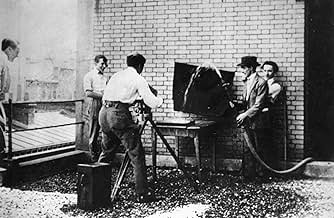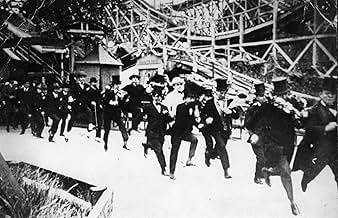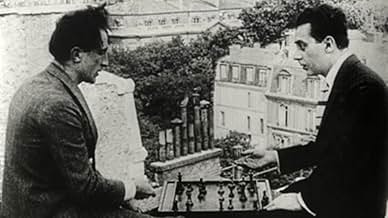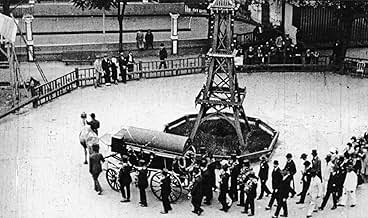PUNTUACIÓN EN IMDb
7,3/10
4,4 mil
TU PUNTUACIÓN
Añade un argumento en tu idiomaAn absolute dada movie. Somebody gets killed, his coffin gets out of control and after a chase it stops. The person gets out of it and let everybody who followed the coffin dissapear.An absolute dada movie. Somebody gets killed, his coffin gets out of control and after a chase it stops. The person gets out of it and let everybody who followed the coffin dissapear.An absolute dada movie. Somebody gets killed, his coffin gets out of control and after a chase it stops. The person gets out of it and let everybody who followed the coffin dissapear.
- Dirección
- Guión
- Reparto principal
Inge Frïss
- La ballerine
- (as Mlle Frïss)
Man Ray
- Un joueur d'échecs
- (as Man-Ray)
Marcel Achard
- Un homme qui suit le corbillard
- (sin acreditar)
Georges Auric
- Un homme qui suit le corbillard
- (sin acreditar)
Georges Charensol
- Un homme qui suit le corbillard
- (sin acreditar)
Georges Lacombe
- Un homme qui suit le corbillard
- (sin acreditar)
Roger Le Bon
- Un homme qui suit le corbillard
- (sin acreditar)
Jean Mamy
- Un homme qui suit le corbillard
- (sin acreditar)
Rolf de Maré
- Un homme qui suit le corbillard
- (sin acreditar)
Erik Satie
- Un homme qui charge le canon
- (sin acreditar)
Pierre Scize
- Un homme qui suit le corbillard
- (sin acreditar)
Louis Touchages
- Un homme qui suit le corbillard
- (sin acreditar)
Reseñas destacadas
Originally played as an intermission with no sound, this film is now a must for any fan/historian of fine art. Featuring cameos by Man Ray, Marcel Duchamp, and other notables, Clair and Picabia's dada collage of different narratives, experimental use of the camera, and surrealist and absurdist images is the best example of experimental or dadaist films from the period. As unusual as it is to watch a film with no sound, the images created by the artists provide an extremely unique experience for the viewer. Fun for anyone, and especially interesting for those acquainted with the artists or the art movements themselves.
This is an avant-garde movie and as such it's theme and plot are unclear, which is as intended because the movie is ore about special effects than about telling an actual story. This movie directs the audiences' attention to such everyday occurrences as movement, personal interactions, dancing, and running. People are part of some kind of funeral procession, but what catches the attention is the various actions that take place as the procession proceeds. Mourning is replaced by an almost frenetic need to stay active, and the movie shows this through the use of some innovative techniques, including slow-motion, use of montage, and multiple superimposed exposures, all of which convey the sense that something intense is happening. This movie is an excellent example of the French avant-garde genre which had a major influenced on cinematic styles in Europe and the United States.
We were shown this film in a class where at least once during each class, I start to nod off to sleep. Maybe it's the time of day, or the too-dark lights, but even during one of the Jean Vigo films we saw it didn't grab me. This one did, however, as it is one of the best short films of the 20's, or at least one of the more ambitious ones of the time. There are plenty of Freudian symbols, or maybe spoofs and in-jokes on the symbols (i.e. phallic imagery, cannons, guns, balls, and obsessions with looking up women's skirts).
But more importantly there is an almost need to break through anything expectable. Unlike Bunuel's Un Chien Andalou, however, Entr'acte even goes for the manic and cartoon-like. Like Bunuel's film, there COULD be a certain thread of a story in the proceeding, if you try to take one to mind- here the story could be the unexpected tragedy of death turned up on its own head. However there is also the latter part of the film, which involves a large group running after (in trademark, hilarious fast-motion film) a hearse running down a road. It's a kind of peak of stimulating silent-film cinema, where everything being done can now be just as easily done- and is- on a daily basis by music video directors.
Yet Clair is so inventive with his techniques, of pushing a speed and tempo with his style, that it works well despite making no sense on the surface. It's a film made in the heights of French impressionism and surrealism, and the almost sheer confidence of the filmmaker here propels it into being unforgettable in a way. Most will seek out the Bunuel early works first, of course, but along the way this is worth a shot. At the least, you'll have your own interpretation once its done, not shoved down your throat.
But more importantly there is an almost need to break through anything expectable. Unlike Bunuel's Un Chien Andalou, however, Entr'acte even goes for the manic and cartoon-like. Like Bunuel's film, there COULD be a certain thread of a story in the proceeding, if you try to take one to mind- here the story could be the unexpected tragedy of death turned up on its own head. However there is also the latter part of the film, which involves a large group running after (in trademark, hilarious fast-motion film) a hearse running down a road. It's a kind of peak of stimulating silent-film cinema, where everything being done can now be just as easily done- and is- on a daily basis by music video directors.
Yet Clair is so inventive with his techniques, of pushing a speed and tempo with his style, that it works well despite making no sense on the surface. It's a film made in the heights of French impressionism and surrealism, and the almost sheer confidence of the filmmaker here propels it into being unforgettable in a way. Most will seek out the Bunuel early works first, of course, but along the way this is worth a shot. At the least, you'll have your own interpretation once its done, not shoved down your throat.
While not nearly as well-recognized or well-remembered as the Luis Bunuel classic "Un Chien Andalous" (1929), "Entr'acte" is a fairly known work in Dadaism of the 1920's, possibly one of the earliest shorts to focus on the avant-garde rather then attempt a story. Intended as an "entr'acte" (so the title suggests) for the French ballet "Relâche", the film appears to be a mere experimentation with effects while crafting a rather odd plot in the process--and more of a plot than most of the surrealistic works contain. Quite sadly, it was Rene Clair's only attempt at such a form of filmmaking, and had he gone on to lead the movement further he may have come up with even crazier material.
The image most of us remember when we think of this movie (if we do think of this movie, which many may not) is the shot of the bearded ballet dancer, reportedly played by Clair himself. This is a rather odd sight to see in a movie, and one you wouldn't normally see--likewise the rest of the short. Experimenting with slow motion, reverse motion, upside-down and side-to-side camera angles, and a number of dizzying double-exposures, the film's narrative is a rather odd one of a man shooting at a large egg only to be murdered by another man afterwards. This sets up the strange premise and the rest of the film is largely a crazy chase as the mourners of the man pursue his coffin after the hearse gets out of control. The ending, not to be spoiled, (although already spoiled by IMDb's summary) is a weird one to boot.
As others have commented, this short is hardly dark and is more of a comedy to watch than the later surrealist efforts. Plus, the opening sequences (such as the balloon dolls) hardly have anything to do with the rest of the short and the ballet dancer is entirely unconnected to the rest of it. It feels as though they were taking the first few minutes to experiment with other visuals before progressing with the true 'narrative', if one could call it that. Not to be considered a surrealist film, however; the wonderfully dizzying use of exposures is pure Dada all the way. A very creditable early effort in its exceedingly memorable imagery, and every bit as deserving to be a landmark classic as "Un Chien Andalou".
The image most of us remember when we think of this movie (if we do think of this movie, which many may not) is the shot of the bearded ballet dancer, reportedly played by Clair himself. This is a rather odd sight to see in a movie, and one you wouldn't normally see--likewise the rest of the short. Experimenting with slow motion, reverse motion, upside-down and side-to-side camera angles, and a number of dizzying double-exposures, the film's narrative is a rather odd one of a man shooting at a large egg only to be murdered by another man afterwards. This sets up the strange premise and the rest of the film is largely a crazy chase as the mourners of the man pursue his coffin after the hearse gets out of control. The ending, not to be spoiled, (although already spoiled by IMDb's summary) is a weird one to boot.
As others have commented, this short is hardly dark and is more of a comedy to watch than the later surrealist efforts. Plus, the opening sequences (such as the balloon dolls) hardly have anything to do with the rest of the short and the ballet dancer is entirely unconnected to the rest of it. It feels as though they were taking the first few minutes to experiment with other visuals before progressing with the true 'narrative', if one could call it that. Not to be considered a surrealist film, however; the wonderfully dizzying use of exposures is pure Dada all the way. A very creditable early effort in its exceedingly memorable imagery, and every bit as deserving to be a landmark classic as "Un Chien Andalou".
Entr'acte is a light-hearted example of Dada cinema of the 1920's. The tone is consistently playful and silly and you can just tell that the film-makers are having a laugh throughout. I'm certainly not too convinced that there is any particular message here. The emphasis of the film is using the cinematic medium to showcase inventive and surreal imagery in an amusing way. The narrative, such as it is, has us follow a funeral march. Although seeing as this is a Dada film, it's not exactly an ordinary march. For one thing it's led by a camel, and for another, the people in the procession bound around in slow motion for no discernible reason other than it looks funny.
The film itself was conceived as something to be shown in an intermission between other films. It clearly was never meant to be taken too seriously, and it's quite obvious that it was made in a way that allowed some of the leading proponents of the Dada/Surrealist movement to have fun and go for laughs. Surrealism was often an art-form with a sense of humour in any case, as anyone familiar with Salvador Dali's work could attest. Like most art films from the 20's Entr'acte has aged remarkably well and like others displays a sensibility that would be replicated many decades later in avant-garde cinema of the 60's and pop videos of the 80's and beyond. All-in-all a fun film to see.
The film itself was conceived as something to be shown in an intermission between other films. It clearly was never meant to be taken too seriously, and it's quite obvious that it was made in a way that allowed some of the leading proponents of the Dada/Surrealist movement to have fun and go for laughs. Surrealism was often an art-form with a sense of humour in any case, as anyone familiar with Salvador Dali's work could attest. Like most art films from the 20's Entr'acte has aged remarkably well and like others displays a sensibility that would be replicated many decades later in avant-garde cinema of the 60's and pop videos of the 80's and beyond. All-in-all a fun film to see.
¿Sabías que...?
- CuriosidadesThe ballet "Relâche" ("Theatre Closed") premiered at the Théâtre des Champs Elyseés in Paris on December 4, 1924. Based on a book and with settings by Francis Picabia, it was a ballet in two acts commissioned and staged by the Ballets Suédois of Rolf de Maré, with choreography by Jean Börlin. As the title "Entr'acte" implies, this film was shown between the two acts, with music by Erik Satie.
- PifiasObvious stand-in for the close-up of Rolf de Maré getting kicked in head, which sends him (via reverse motion) flying back into the end title. The "kick" itself is clearly achieved through reverse motion.
- Versiones alternativasThere is an Italian edition of this film on DVD, distributed by DNA Srl (2 Films on a single DVD). The film has been re-edited with the contribution of film historian Riccardo Cusin. This version is also available for streaming on some platforms.
- ConexionesEdited into Avant-garde Cinema (1960)
Selecciones populares
Inicia sesión para calificar y añadir a tu lista para recibir recomendaciones personalizadas
Detalles
- Duración22 minutos
- Color
- Mezcla de sonido
- Relación de aspecto
- 1.33 : 1
Contribuir a esta página
Sugerir un cambio o añadir el contenido que falta






















